Workplace
Employers incur $15,000 per year in lost productivity, health care costs, and turnover for every employee who is experiencing emotional distress (NCS, 2023)1. Additionally, depression leads to a significant reduction of 11.5 days in productivity every three months, with performance impairment spanning one to two hours within an eight-hour workday (Health Action, 2023)2. Gallup (2021)3 recently wrote that hope is one of the four basic needs in strength-based leadership.
Hopelessness, the primary symptom of depression and a key symptom of anxiety; it is one of the greatest costs to employers. You can use the One Mind at Work calculator to see specific costs to your workplace:
Take Action with the following interventions:

International Day of Hope
The International Day of Hope, scheduled May 1st, provides an opportunity for global solidarity. On this day, we come together to share the science, stories, and strategies of hope and actively engage in implementing hope in our lives and communities worldwide. Our goal is to advocate for the establishment of The International Day of Hope through an official United Nations resolution. This initiative will kick off a five-day campaign featuring the Five Day Global Hope Challenge, yard signs, sunflower gardens, workplace educational posters, sunflower Shine murals, live speaking events, classroom teachings of Hopeful Minds, and more.
We encourage Mayors, Governors, and schools to issue proclamations for their towns and environments, demonstrating solidarity in officially recognizing the day and joining the Hopeful Cities Movement.
Five-Day Hope Challenge & Social Media Campaign
The Five-Day Global Hope Challenge is a five-day e-mail challenge ensuring all know the what, why, and how to hope. It reviews what hopelessness is, the Shine Hope framework, and instructs how to measure hope. It is a simple way to get started learning how to Shine Hope.
Social media is a great way to share the resources available for hope with your friends, family, and community, so we have created a social media toolkit for hope as well. All of our images and content are available to download at no cost to share and activate the message for hope.
Download the Hope Challenge Social Media Kit for daily social media posts:
You can also help your community access the Hopeful Cities resources by tagging us in your posts using @theshinehopecompany @ifredorg #HopefulCities #Hope
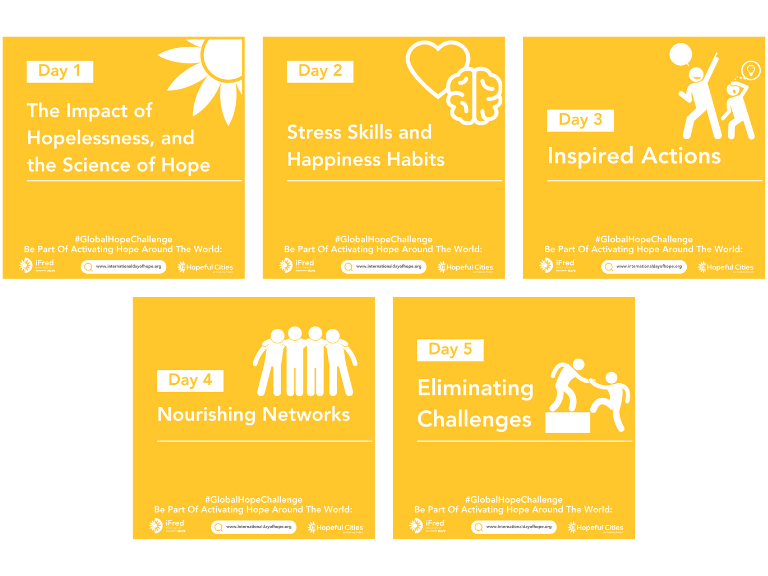
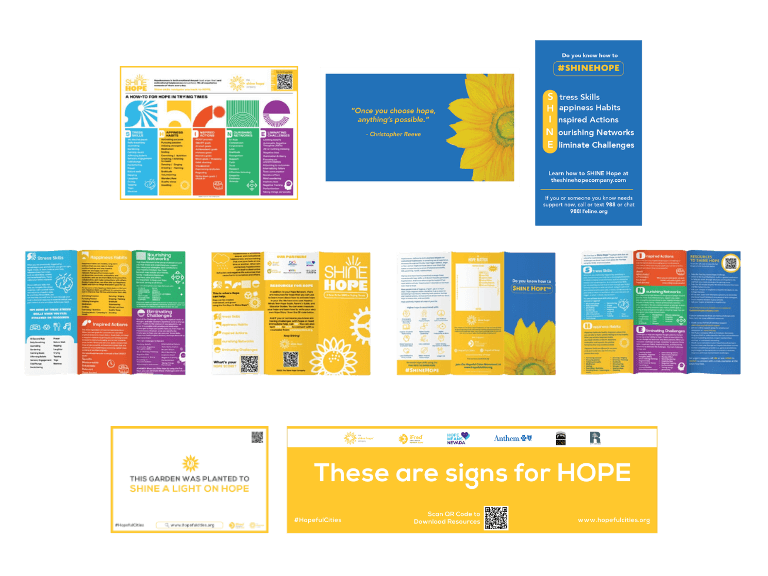
Digital Communication Assets: Shine Hope Infographic, Moment of Hope Cards, Teen and Adult Brochures, Posters, Signs, and Billboards
Our digital communications provide an opportunity to educate all on the Shine Hope framework in an easy-to-understand way. We have an infographic and digital downloadable tool for newsletters or social media posts to describe the Shine Hope framework at no cost.
We have two brochures that are great for sharing in newsletters or other city-wide communications. Our Digital Shine Hope Brochure is geared toward adults, while our Teen Shine Hope brochure is similar, yet more teen-friendly. Both brochures include tips on the Shine Hope framework, and have resources to help elevate hope in your life and with others.
We also have Shine Hope Posters you can use as individual images, or on web portals, that give more details into the Shine Hope Framework. Lastly, we have a Sunflower Fascinating Facts poster for some interesting tidbits on sunflowers, if you have an interest!
Workplace Research
Encourage all those in your company to measure hope, so we can start tracking hopefulness in individuals around the world.
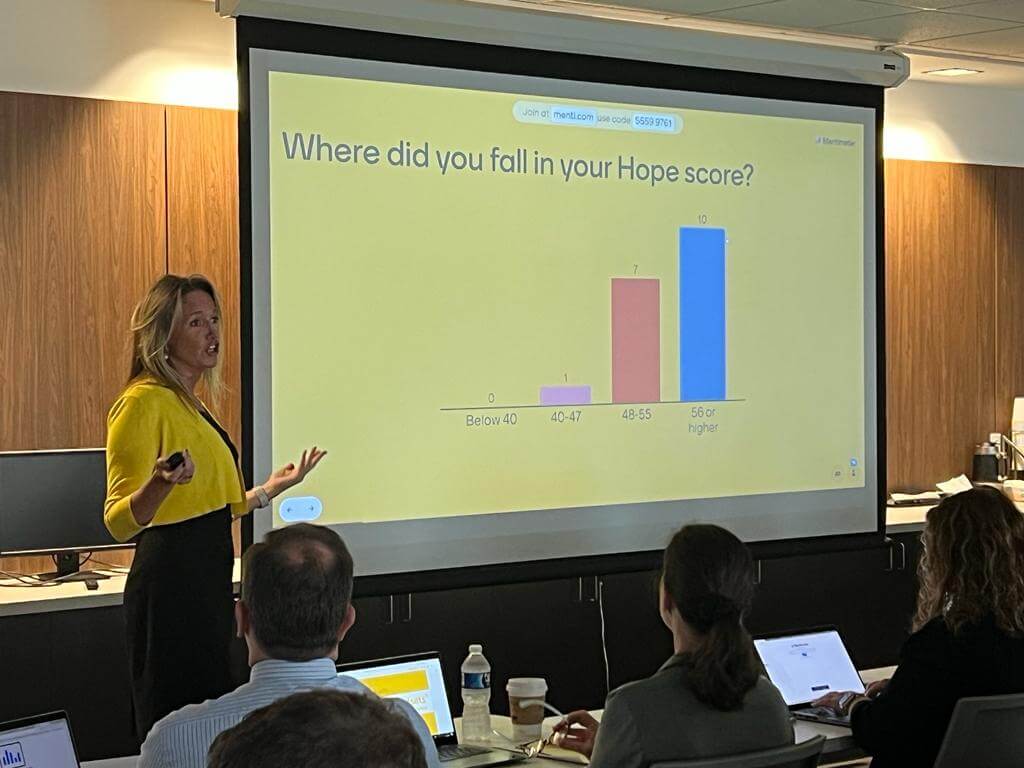

Cause Marketing Campaign
Cause marketing is a great way to activate and educate around hope. We partner with brands and retailers to license our Shine Hope framework, and work to share the skills and support the work we do in low income areas with the nonprofit we support iFred. If you are a brand, join our mission to teach hope around the world, and work with us to create a cause marketing campaign about the “how to” of hope.
If you are interested in working with us on a cause marketing campaign, email us at activate@theshinehopecompany.com
Employee Volunteer Opportunities
Our Hopeful Minds programs are all scripted, so your employees are able to work with local schools, after-school programs, youth groups, or other places kids gather to help teach hope. There are also opportunities to plant gardens or do art projects in low-income areas.
Email us if you want to activate your employees at activate@theshinehopecompany.com.

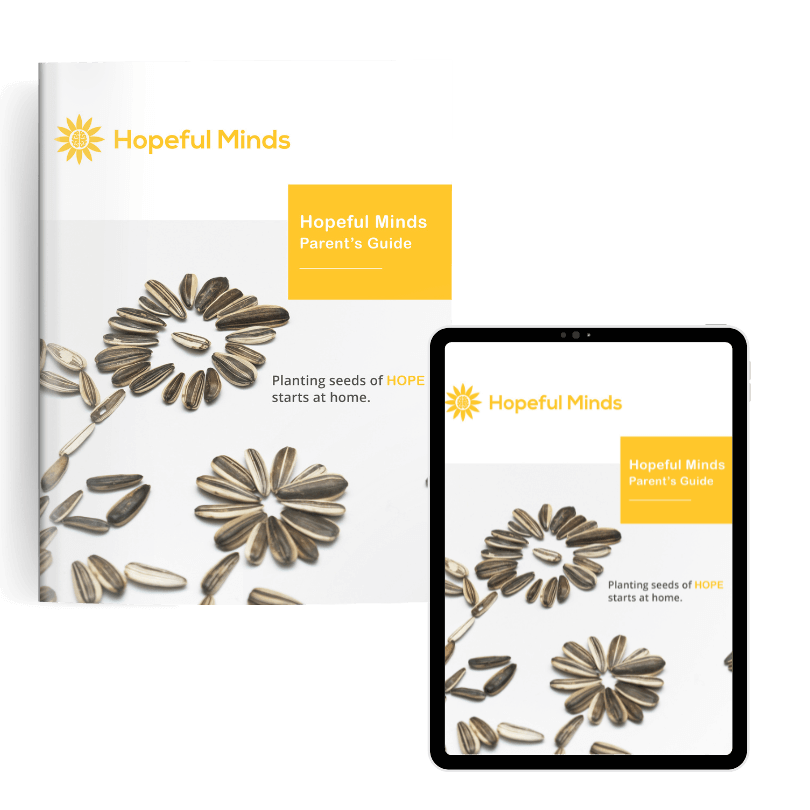
Hopeful Minds Parent’s Guide Digital Version and Print Version
The Hopeful Minds Parent’s Guide provides a broad overview of the concepts discussed in the Hopeful Minds curriculums, and provides parents with easy ways to implement the Five Keys to Shine Hope (Stress Skills, Happy Habits, Inspired Actions, Nourishing Networks, and Eliminating Challenges) and hopeful language in the home. It is helpful when parents reinforce hope language at home, so the family can practice together.
Hope is measurable and teachable. With hopelessness at an all-time high in youth, we’ve got to be proactive about practicing these skills with youth. This is a tool parents can use to talk about mental health in a positive, proactive way at home and know what to look out for and find resources for support.
The digital guide is available at no cost:
$ We recognize some may prefer hard copies of our programming. Get your copy here:
Hopeful Minds Overview K-6 Digital Version and Print Version
The Hopeful Minds Overview is a curriculum designed to give children an introduction to the “what,” “why,” and “how” of hope. The curriculum includes three, one-hour lessons that introduce the key tools needed to create, maintain, and grow hope. Additionally, the curriculum includes background information for educators, supplemental resources, classroom visuals, and a Hopework Book for students.
While this curriculum is geared towards 2nd-grade students, it can be easily adapted for any age range (adults included) and can be utilized in any setting (such as schools, after-school programs, places of worship, hospitals, offices, and more). This curriculum has been specially designed to be used for either classroom or remote learning.
The digital guide is available at no cost. This is the downloadable version of the curriculum, and we have downloadable fillable workbooks as well:
$ We recognize some may prefer hard copies of our programming. Get your copy here:
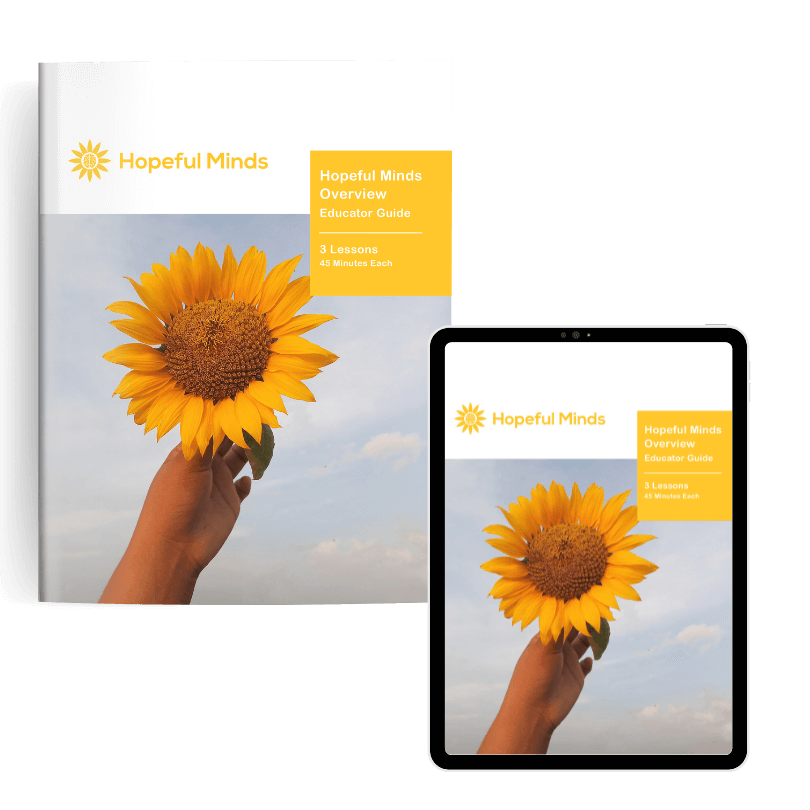
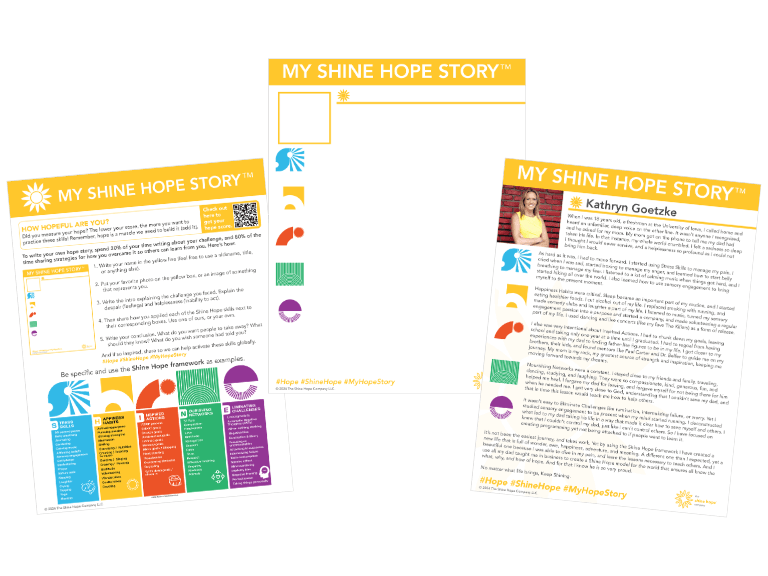
My Shine Hope Story™ Template for Leadership
My Shine Hope Story™ gives community leaders an avenue to normalize hopelessness and share their unique experiences by using the Shine Hope framework. We all experience moments of hopelessness (i.e., emotional despair and motivational helplessness). How we manage the moments of hopelessness matters.
We suggest you share a recent challenge, large or small. We encourage you to spend 20% of the time describing what the hopelessness was about (sadness, anger, fear, and powerlessness). We then ask you to spend 80% of the story sharing how you overcame it.
What Stress Skills did you use? What Happiness Habits did you practice? What Inspired Actions did you take to make it through? How did your Nourishing Networks support you? And what was one of your biggest challenges (i.e., negative thought pattern), and how did you overcome it?
We created an outline for you to use while creating your Hope Story, and you can use our Shine Hope infographic for some ideas.
We encourage you to share your story with the community while encouraging others to share their stories as well. Discuss what skills work, help all practice, and be sure people know where to go for support if they are having challenges in your city.
If you want to share your hope story on social media, we encourage you to do so. Please tag us @ifredorg @theshinehopecompany #myhopestory #myhopehero so we can share with others.
Workplace Leadership & Management Training
We offer diverse options for management and leadership training, incorporating the measurement of managers’ hope levels and the use of the VIA Strength Finder—a powerful tool that identifies strengths to optimize overall leadership performance.
This training covers various aspects, including insights into the Hope Matrix, an exploration of the definition and consequences of hopelessness, and the provision of strategies for proactively managing moments of hopelessness while instilling the necessary skills to activate hope. Managers are specifically guided on the effective application of the Shine Hope framework in their leadership roles, integrating our Hopeful Minds Overview for the Workplace workbook. They are encouraged to explore how hope can serve as inspiration and support for their teams.
The primary goal is to equip company leaders with essential skills and ensure their awareness of available resources before reaching a crisis point. The program is delivered through a 90-minute in-person meeting, fostering a collaborative environment that emphasizes learning and practical application.
For executive leadership, high-level Leadership Training is offered to provide a profound understanding of the science of hope. This training introduces the Shine framework, offering strategies and techniques to nurture hope in the workplace. It includes a presentation tailored to industry-specific statistics. Your leadership team will gain insights into the psychology of hope, measurement methods, industry-specific hope considerations, cultivating hopeful mindsets, and the practical application of hope in leadership. The executive leadership training session is designed to meet the needs of top leaders and their busy schedules and thus are shorter (i.e., 15- 60 minutes); however, the training can be tailored according to needs.
To complement management and leadership training, the Hopeful Mindsets Workplace Overview video course serves as an excellent addition, ensuring that entire companies understand the what, why, and how of hope.
To learn more about the management and leadership training, please email us at activate@theshinehopecompany.com.

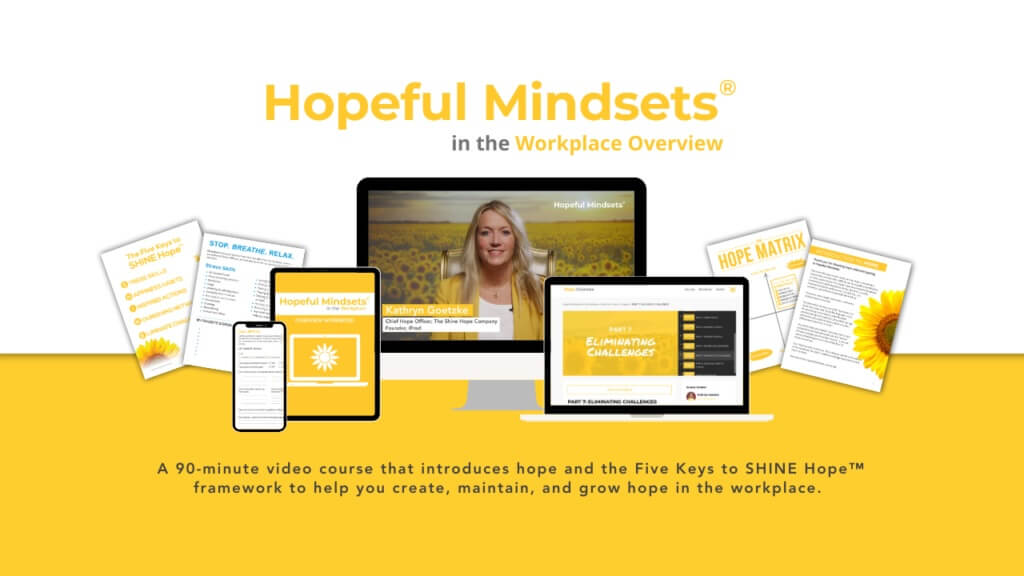
Hopeful Mindsets Overview Workplace Video Course License
The Hopeful Mindsets Overview Workplace Video Course offers a comprehensive understanding of hope and its practical application in the workplace. The annual license grants access to the 90-minute video course for up to 250 employees, providing them with the tools and knowledge to cultivate hopeful mindsets and promote a positive work environment. We will also provide access to Shine Hope Posters that can be used to reinforce the Shine framework throughout the workplace.
For bulk license, e-mail us at activate@theshinehopecompany.com.
Workplace Keynotes
A workplace keynote presentation offers the chance to address your entire healthcare center or present at a prominent industry conference, delivering a 60-minute session focused on teaching hope. Our objective is to gauge the level of hope among employees in real-time and subsequently delve into the essential skills about the what, why, and how of hope. Participants will gain insights into effectively applying the Shine framework in their respective roles, integrating the workbook associated with the overview video course, and exploring methods to inspire and support their teams.
To request Kathryn Goetzke to keynote, please email us at activate@theshinehopecompany.com.
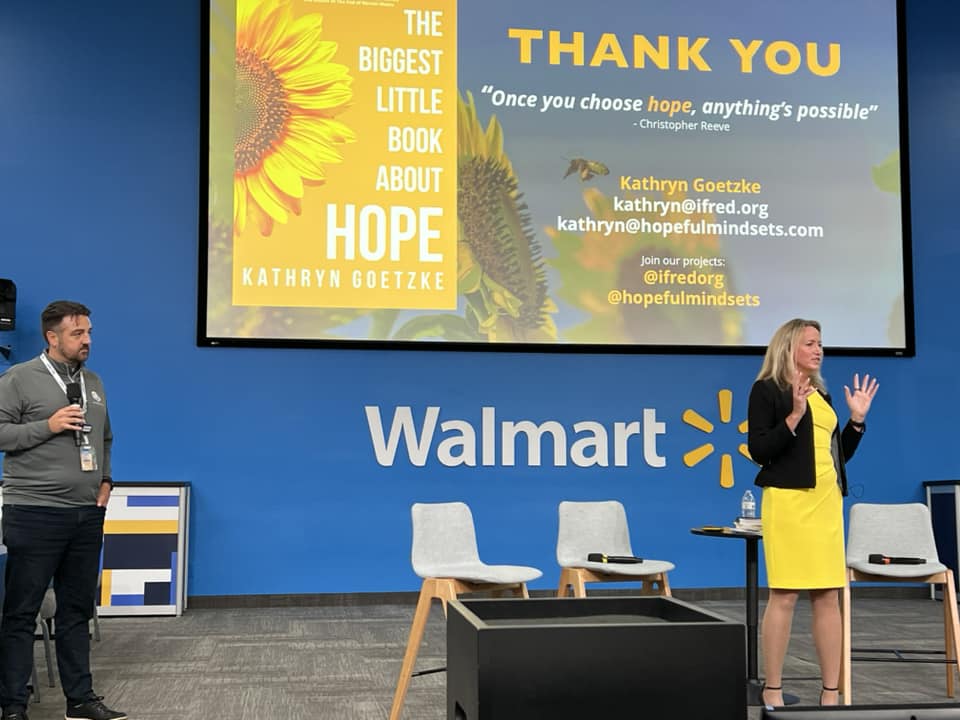
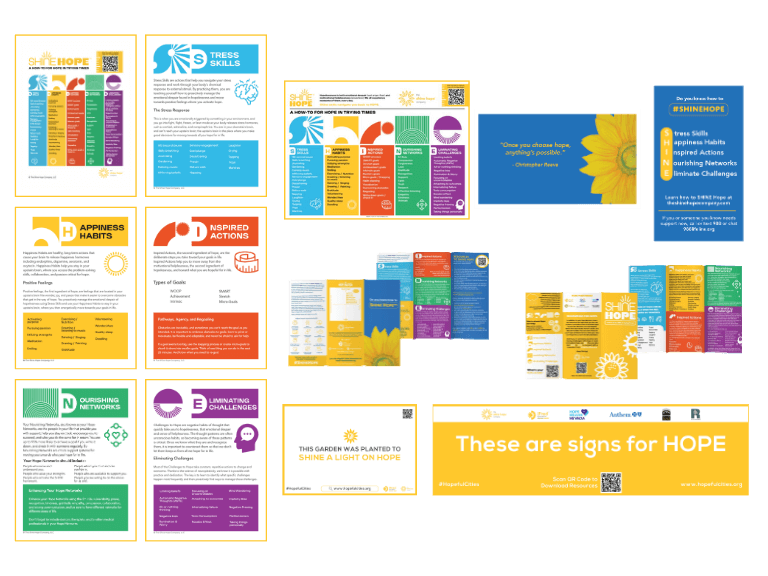
Printed Shine Hope Educational Materials for Staff and Waiting Rooms: Moments of Hope Cards, Teen and Adult Brochures, Posters, Signs, and Billboards
Our print communications provide an opportunity to educate all on the Shine Hope framework in an easy-to-understand way. We want to ensure all are equipped with a crisis hotline and skills to proactively activate their hope. It is our goal to ensure all know that hope is a skill, measurable, and teachable.
We have two brochures, a general one and a teen-focused one, available for waiting rooms, community centers, lobbies, offices, or libraries. We have posters for the walls in workplaces, coffee shops, libraries, or waiting rooms, and Moments of Hope cards to hand out anywhere people gather. Lastly, we have a Sunflower Fascinating Facts poster for some interesting tidbits on sunflowers, if you have an interest! All of these print materials serve as a cost-effective approach to getting the word out about hope, and start equipping the population to take a proactive approach to managing hope in their life and the lives of others.
